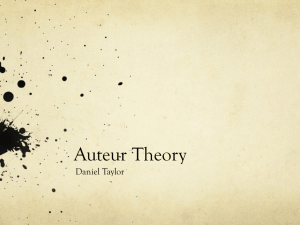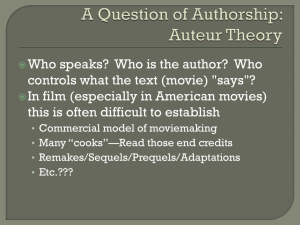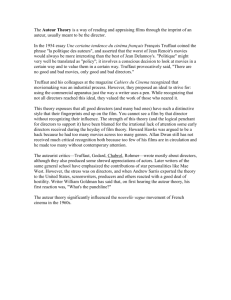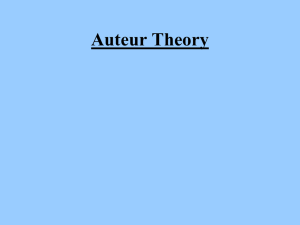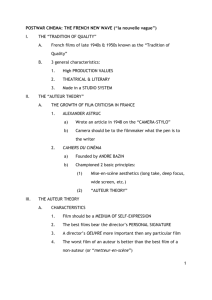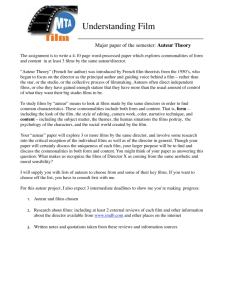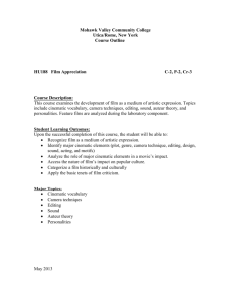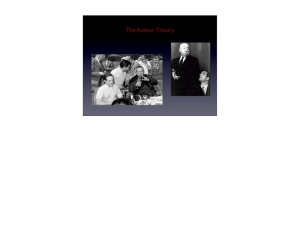Auteur
advertisement
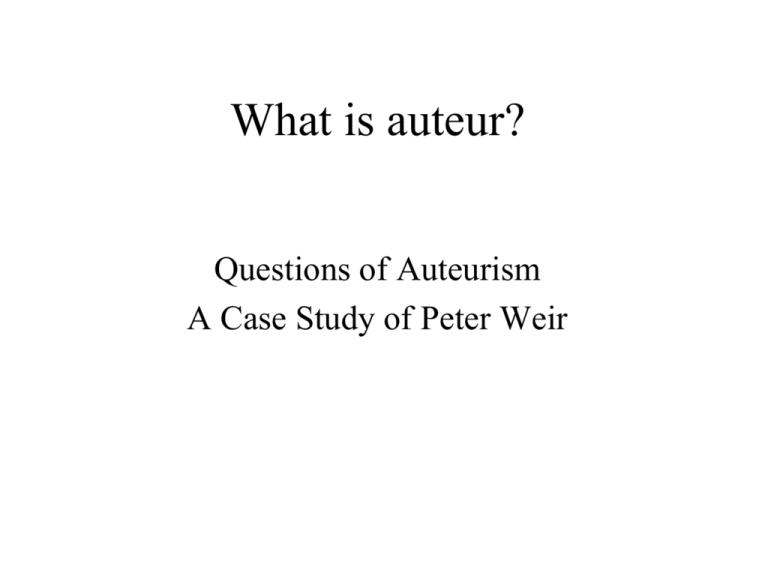
What is auteur? Questions of Auteurism A Case Study of Peter Weir What is auteur? 1 A director who make films which reflect his/her personal vision and preoccupations. 2 A director who has a distinctive style and consistent themes. SIGNATURE Vision SIGNATURE Style François Truffaut, ‘Une Certaine tendence du cinéma française’ (A Certain Tendency in the French Cinema) 1954 What is auteur? • Though film making is collaborative work • Directors called auteurs oversee all narrative, visual and audio elements of motion pictures. • “The filmmaker/author writes with his camera as a writer writes with his pen.” ‘Caméra Stylo’ (camera-pen) Alexander Astruc, ‘Naissance d’une nouvelle avant-garde’, L’Ecran Français, 30th March, 1948 What is auteur? • Auteur or metteur-en-scène • Auteur - a director who expresses his/her unique preoccupation and holds on to his/her signature style • Metteur-en-scène (one who puts it in the scene theatre director) - a (highly) competent film maker but lacks ‘the consistency that betrayed the profound involvement of personality’ Who Are Auteurs? • Directors who have a distinct visual style … • Directors who have a consistent theme … Jean Renoir (humanism), Douglas Sirk (melodrama) … Theo Angelopoulos (modern Greek history), Ken Loach (left-wing social consciousness) Alfred Hitchcock Orson Welles Stanley Kubrick Wong Kar Wai Jean Renoir Douglas Sirk Theo Angelopoulos Ken Loach Auteur Theory (Politique des auteurs) • Auteur theory - a critical attitude to consider a film as a product of a single person director - auteur • Andrew Sarris, ‘Notes on the Auteur Theory’, 1964 Auteur Theory (Politique des auteurs) Film criticism and film studies based on auteur theory: (1) to analyse a film as a work of a single author (auteur) → auteurism (2) to identify the characteristics of a director’s work which makes him a auteur → auteurism Criticism against auteur theory • Filmmaking as collaborative and collective actions. • Making a film involves many other creative talents than director. • Scriptwriter, photographer, editor, art director, actor, etc. Criticism against auteur theory Figures other than directors, who played a prominent role include: Cesare Zavattini (19021989) Screenwriter for Vittorio De Sica and Luchino Visconti Shoeshines, Bicycle Thieves, Umberto D, Bellisima, etc. Criticism against auteur theory Ruth Prower Jhabvala (1927 - ) Screenwriter for James Ivory Room with a View, Howard’s End, Remains of the Day Criticism against auteur theory Gordon Wills Most important cinematographer in the 70s and 80s The Godfather, Annie Hall, Manhattan, All the President’s Men Gordon Willis, Manhattan Gordon Willis, The Godfather Gordon Willis, Annie Hall Gordon Willis, All the President’s Men Criticism against auteur theory • Vittorio Storaro • Italian cinematographer who have worked for first Bernardo Bertolucci, and then Carlos Saura and Francis Ford Coppola Vittorio Storaro, Last Tango in Paris Vittorio Storaro, Goya Criticism against auteur theory • Miyagawa Kazuo (1908-1999) Greatest Japanese photographer, operated the camera and shot for Mizoguchi Kenji, Kurosawa Akira, Ichikawa Kon and Shinoda Masahiro Rashomon, Ugetsu, Yojinbo, Tokyo Olympiad, McArthur’s Children Kazuo Miyagawa, Rashomon Kazuo Miyagawa, Ugetsu Kazuo Miyazawa, Yojinbo Miyagawa Kazuo, Tokyo Olympiad Kazuo Miyagawa, Floating World Miyagawa Kazuo, McArthur’s Children Criticism against auteur theory • David Lean (1908-1991) British film director Established the classic editing techniques Edited for film directors such as Anthony Asquith and Michael Powell Pygmalion, Major Barbara, 49th Parallel Criticism against auteur theory • Lean edited all his films • His editing techniques and methods influenced may film makers: notably Steven Spielberg and George Lucas. Criticism against auteur theory • Alexandre Trauner (1906-1993) French art and production designer Le Jour se léve, Les Enfants du paradis, Le Portes de la nuit, Kiss Me Stupid, Don Giovanni, Round Midnight, Subway Alexandre Trauner, Les Enfants du Paradis Alexander Trauner, Round Midnight Alexandre Trauner, Don Giovanni Alexandre Trauner, Subway Auteur or Anti-auteur • Positif, founded one year after Cahiers du cinema in 1952 • Firm opposition to author theory • Film making is a collaborative and collective work. • A signed article naming the most overrated directors: Fritz Lang, Nicholas Ray, Howard Hawkes and Alfred Hitchcock • While Cahiers du cinema praised those auteurs to the skies. Criticism against Auteur Theory • Legitimacy of privileging a director - can a director be more important than his film? • ‘There are no good or bad films, but there are only good or bad directors.’ François Truffaut Mizoguchi Kenji (1898-1956) Irredeemable Suffering: Images of Japanese Women Mizoguchi’s Major Works Mizoguchi Kenji (1898 Tokyo - 1956 Kyoto) In the SILENT era • Resurrection of Love (1923) • Bridge of Japan (Nihonbashi, 1929) • Cascading White Threads (Takino Shiraito, 1933) Mizoguchi’s Major Works In the PREWAR period • Osaka Elegy (Naniwa Elegy, 1936) • Sisters of Gion (Gion no Shimai, 1936) • The Story of the Last Chrysanthemum (Zangiku Monogatari, 1939) Mizoguchi’s Major Works • • • • • • POSTWAR masterpieces The Life of Oharu (Saikaku Ichidai Onna, 1952) Ugetsu (Ugetsu Monogatari, 19553) Sansho the Bailiff (Sansho Dayu, 1954) Crucified Lovers (Chikamatsu Monogatari, 1955) The Tales of the Taira Clan (Shin Heike Monogatari, 1955) Street of Shame (Akasen Chitai, 1956) Osaka Elegy (1936) • Ayako becomes the mistress of her boss, so she can pay back her father’s debt and provides her brother with college fees. When she is abandoned by her benefactor, she turns to the street. Sisters of Gion (1936) • Umekichi and Omocha are geisha in Kyoto’s Gion district. The former feels obliged to help her bankrupt patron, but the latter believes her sister is wasting her time and money on a loser and coward. Omocha’s view is vindicated but her pragmatism does not bring her happiness either. The Story of The Last Chrysanthemum (1939) • Kikunosuke, son of a master Kabuki actor, falls in love with Otoku, the wet-nurse of his brother. This provokes his father’s anger and he is expelled from his troupe. He is allowed to rejoin it on the condition that he separates from Otoku. The Life of O-haru (1952) • Once a lady-in-waiting at the imperial court, Oharu falls in love with a man below her station. They are forced to be separated. Oharu is sent to the court as concubine for the lord who lacks a male heir. The lord’s infatuation and obsession with Oharu caused jealousy among his first wife and court ladies. After giving birth to a baby boy, The Life of O-haru (1952) she is sent back home. Oharu is then sold to Shimabara as a courtesan to pay off her father’s debt. After leaving Shimabara, she is betrayed by a man who fancies her and her employer. She ends up becoming a cheap street girl. Ugetsu (1953) • A potter is seduced by a wealthy noble woman and abandons his wife. When he comes to his senses and returns to his home, he is kindly received by his wife, who is but her ghost. Sansho the Bailiff (1954) • A compassionate governor is sent into exile. His wife and children try to join him, but they are separated in the journey. The mother is murdered and the children are sold as slaves. The sister sacrifices in order to liberate her brother. Street of Shame (1956) • About lives of prostitutes in the days before prostitution are banned. Yasumi, the most beautiful and successful, manipulates customers; Mickey is an unsentimental rebel; Michi’e supports her sick husband and a new-born baby; Yumeko supports her son but is ashamed of her profession; Yori’e hopes to settle into marriage but is betrayed by her ‘fiancée’. Images of Japanese Women • Mizoguchi’s thematic concerns consistently found in his films His films reflect: • (Expected) roles of women in the feudal and traditional society • Exploitation and abuse of women – as the ‘second-class’ members of the society. Images of Japanese Women • Ugliness of men who prey on women • Beauty of women who resist the power of men but finally succumb to it. • Women’s self-sacrifice (or forced self-sacrifice) for their family (parents, brothers and sisters, husbands, children, and lovers) • Atonement brought for the sin committed by men by way of women’s self-sacrifice Images of Japanese Women • ‘… a commitment to feminism and progressive politics…’ Interpretation by Alexander Jacoby • Are Mizoguchi’s films feminist and do they take a progressive political stance on issues of women? • Comassion and sympathy towards suffering women; indictment against men’s cruelty, selfishness and violence Images of Japanese Women • Female perseverance and self-sacrifice are made to look as if they were beautiful and virtuous acts • Isn’t this the glorification of women’s suffering rather than denouncement. • Female masochism • Doesn’t this lead to a tacit affirmation of the position and role of women?
